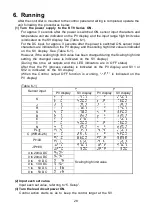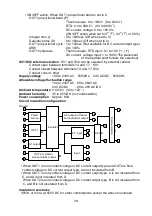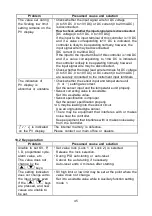
38
Input
Thermocouple
: K, J, R, S, B, E, T, N, PL- , C (W/Re5-26)
External resistance, 100
or less,
however, for B, 40
or less
RTD
: Pt100, JPt100, 3-wire system
Allowable input lead wire resistance, 10
or less per wire
DC current
: 0 to 20mA DC, 4 to 20mA DC
Input impedance, 50
[50
shunt resistor (AKT4810, sold separately) must be
connected between input terminals]
Allowable input current 50mA or less
[If 50
shunt resistor (AKT4810, sold separately) is used]
DC voltage
: 0 to 1V DC
Input impedance, 1M
or more
Allowable input voltage 5V or less
Allowable signal source resistance 2k
or less
0 to 10V DC, 0 to 5V DC, 1 to 5V DC
Input impedance, 100k
or more
Allowable input voltage 15V DC or less
Allowable signal source resistance 100
or less
Control output (OUT1)
Relay contact
: 1a1b
Control capacity, 3A
250V AC (resistive load)
1A
250V AC (inductive load cosø=0.4)
Electrical life, 100,000 cycles
Non-contact voltage : 12
+2
0
V DC
maximum 40mA (short circuit protected)
DC current
: 4 to 20mA DC
Load resistance, maximum 550
A1 output
When A1 action is set as Energized, the alarm action point is set by
deviation
from the SV (except Process alarm).
When the input is out of the range, the output turns ON or OFF (in the case of
High/Low limit range alarm).
When the alarm action is set as Deenergized, the output acts conversely.
Setting accuracy : The same as the Indication accuracy
Action
: ON/OFF action
Hysteresis
: Thermocouple, RTD input, 0.1 to 100.0
( )
DC current, voltage input, 1 to 1000
(The placement of the decimal point follows the selection)
Output
: Relay contact 1a
Control capacity, 3A
250V AC (resistive load)
Electrical life, 100,000 cycles
Control action
• PID action (with auto-tuning function)
• PI action: When derivative time is set to 0
• PD action (with auto-reset function): When integral time is set to 0
• P action (with auto-reset function): When integral and derivative times are set to 0











































